16 May, 2023
Social and Geographic Context: Edinburgh Haematology Centre
Tagged by
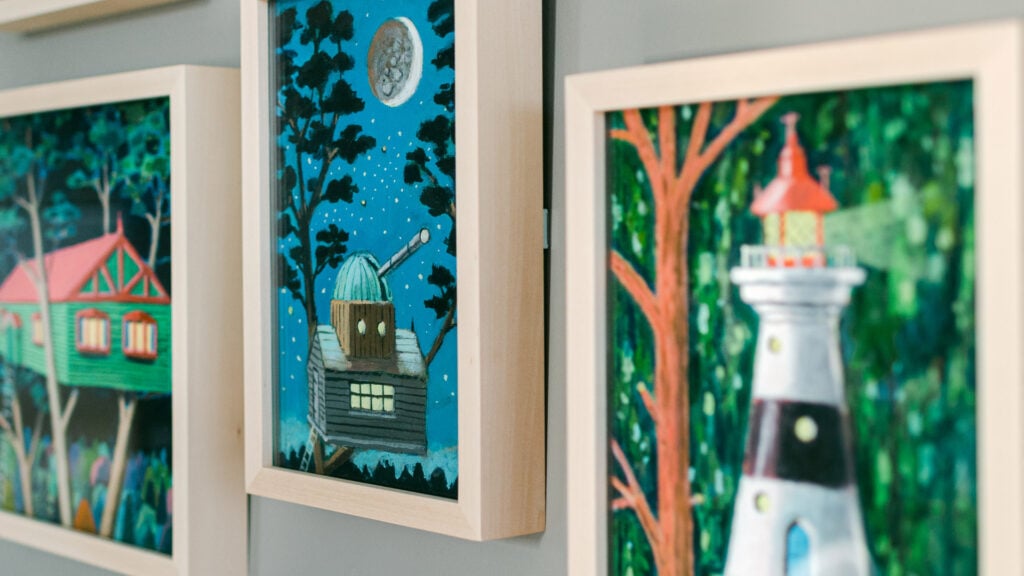
I find myself gazing into a circular haze of blue. I could be looking at a picture of the earth, taken by a satellite from years away. Or perhaps it’s the view from a porthole of an old submarine, where imagined shapes emerge from the darkness of the water. Tracing a line of white that’s half submerged in the blue, I wonder if these are bubbles forming on a distant seashore, contrails in a blue sky glimpsed through binoculars, or the dendritic branches of some ghostly white tree. I am looking at Mary Morrison’s new series of panel paintings, commissioned by Tonic Arts for the newly refurbished Edinburgh Haematology Centre (EHC).
The EHC serves communities from the Borders, through the Lothians, and on to Fife. At the heart of the arts strategy, written by curator Arabella Harvey for NHS Lothian Charity, was a celebration of the natural, cultural and industrial heritage of the Firth of Forth, the beautiful estuary that has shaped this corner of Scotland for millennia.
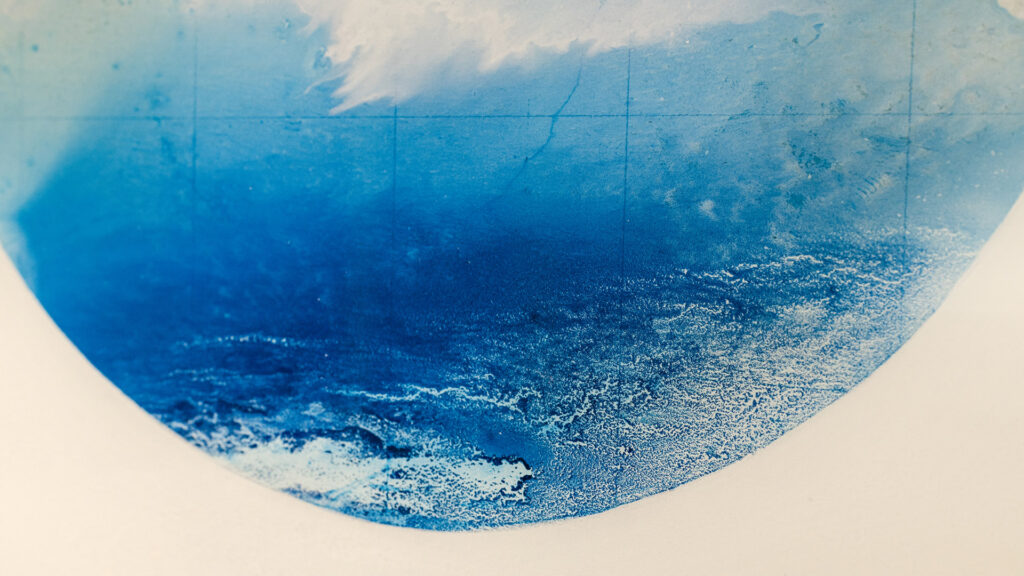
Inspired by this brief, Morrison’s work focuses on the microcosm of water, in all its depth and beauty. These are intimate paintings which invite us further in and, depending on whether we’re up close or stepping away, what we perceive changes, subtly hovering between the figurative and the abstract. These paintings are informed by deeply personal experience, drawing upon Morrison’s own time in hospital recovering from cancer treatment. The idea that more is revealed as the viewer looks closer was important for her: “the hospital environment becomes almost a second home for a lot of patients. The paintings are going to be something that will be revisited, they need to have a certain level of interest and layering.” Moreover, the commission held a profound meaning for her, because as she recovered and regained the strength to walk again, she marked her progress along the hospital corridors by the artworks that lined the walls.
The patient experience is always at the heart of selecting artwork for a hospital, and there is often an understandable desire for works that are imbued with a sense of therapeutic calm. Incorporating patient feedback from previous hospital projects, the commissioning panel also understood that the need for visual stimuli can be equally as strong. Artworks which encourage active looking and engagement can offer much-needed distraction in a clinical environment, thus providing relief for patients, their families, carers and hospital staff.

In her joyful work, Collection – Kirkcaldy Patterns, ceramicist Frances Priest has taken inspiration from the Firth of Forth’s historic craft industries; the former potteries, tileworks and linoleum factories that dotted the estuary and which boomed alongside the coal mining industries in the area. Priest’s research led her to uncover archival patterns for linoleum created in Kirkcaldy, Fife, which she has replicated in a series of sculptural ceramics. Each hand-sized piece boasts a striking abstract design, with shapes recalling an hourglass, a beehive and dice from a board game. Though the pattern and form of each piece is different, they tessellate conceptually and will be displayed together in the Family and Friends’ Room. As the artist has explained;
Putting craft in this context is like an act of care – it is nurturing and humane”. They are exquisitely hand-crafted pieces that are sure to bring colour and texture to the room, helping create a more welcoming space for everyone who uses it.”
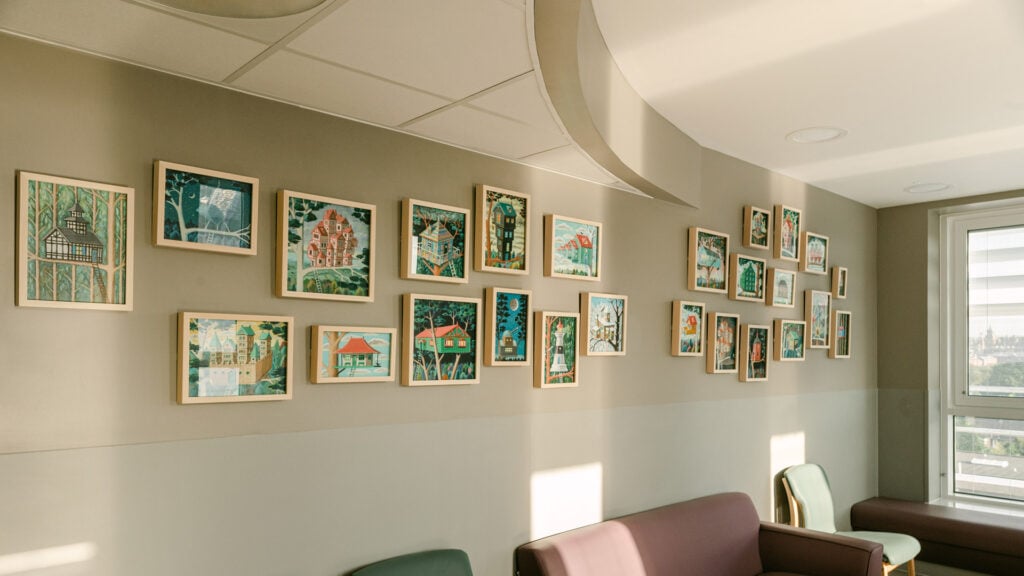
Painter John Brown’s art practice brings constituent pieces together to form a large-scale impressive whole, and for his commission, he has painted 34 small square canvases, each depicting an invented treehouse. The idea was inspired by a visit to the EHC, where he had the sense that the rooms were perched high up in the neighbouring trees.
The treehouses in his paintings take a huge variety of forms, in what Brown calls “mangled architecture”. From fairy-tale castles to spaceships, some are inspired by recognisable Edinburgh buildings, others by allotment sheds and static caravans near the artist’s home in Roslin, Midlothian. From the start it was important for Brown that the canvases worked as individual paintings. Many of the buildings have their lights on inside, and the overall effect is one of warmth, homeliness and charm. With the paintings grouped together, the work becomes a fantasy forest, scattered with dreamlike houses. Brown hopes the installation will provide visual escapism and a sense of fun for the staff taking a break in the respite room, where the work will be displayed.
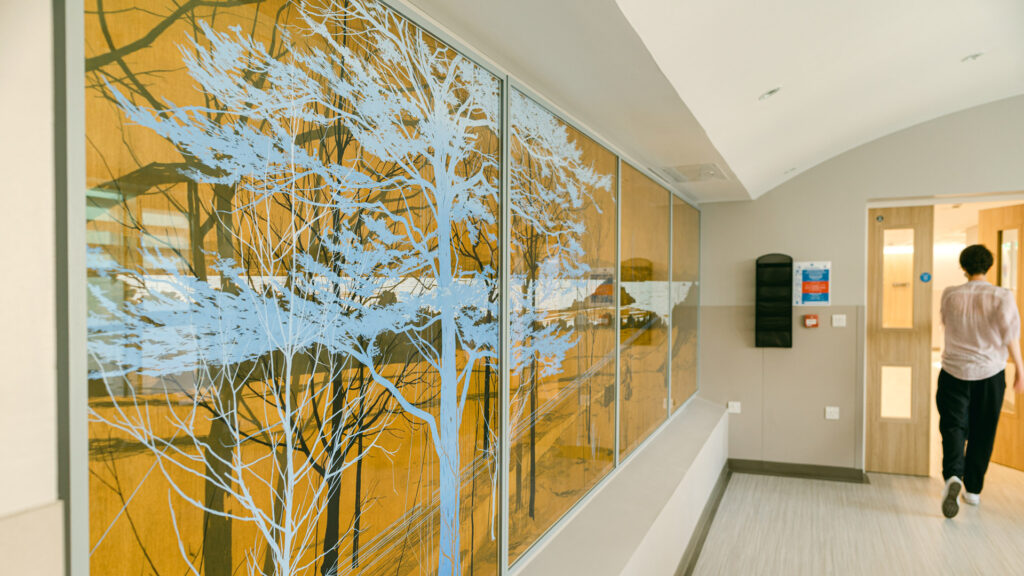
Andrew Mackenzie’s Blue Cedar, Silver Water, is an enormous painting which gives the viewer ample material to decipher. Split into four panels and spanning five metres in total, it is a layered panorama, depicting the Firth of Forth on a majestic scale. Mostly, Mackenzie has used a restricted colour palette; golden brown and silvery white, with delicate dark grey lines to add tone and shading. The panels on the left contrast starkly, dominated by a huge cedar tree painted in electric blue, so bright it almost looks like a negative from a photograph. He uses the same colour to depict the Queensferry Crossing in a complex web of pinpoint-accurate lines. The painting invites us to unravel the layers of what is otherwise a familiar, iconic landmark, encouraging the viewer to try and distinguish between what is natural and what is man-made.
These commissions show how, even with a defined brief, artists’ ideas evolve and take shape in distinctive ways, creating works which will all serve to enhance and soften the EHC environment for patients, families, carers and staff. The final pieces created for EHC could not be more varied in form, material, shape, colour and concept, but that variety is exactly what is needed in a hospital environment. These works will hopefully invoke a dialogue with each person who encounters them, with different elements revealing themselves each time an individual passes by. This dialogue will not only help the EHC community, but will also help to establish the Centre itself, by rooting it in the culture and history of the local area, and by inviting the outside in.

Words by Genevieve Fay
The Art Strategy for the Edinburgh Haematology Centre was delivered by Round Table Projects for NHS Lothian Charity’s Tonic Arts Programme. Promotion in partnership with Craft Scotland.
Download a copy of our case study
Read more of our case studies
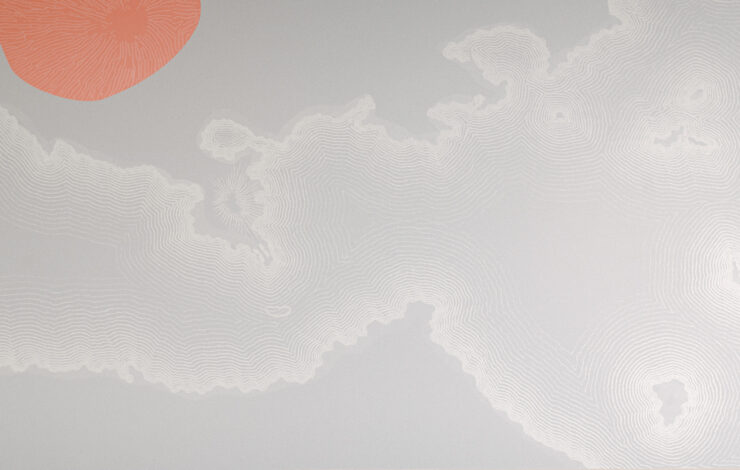
Nature Bathing; Edinburgh Haematology Centre and East Lothian Community Hospital
Humans are genetically predisposed to be attracted to nature. We desire to seek connections to the natural world, which foster […]
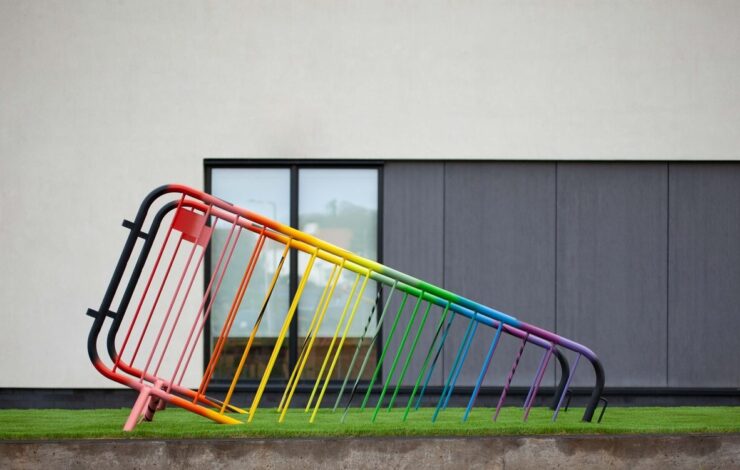
Clinical Collaboration
There’s a multitude of studies with evidence that people actually heal and repair more quickly in a creative physical environment,” […]
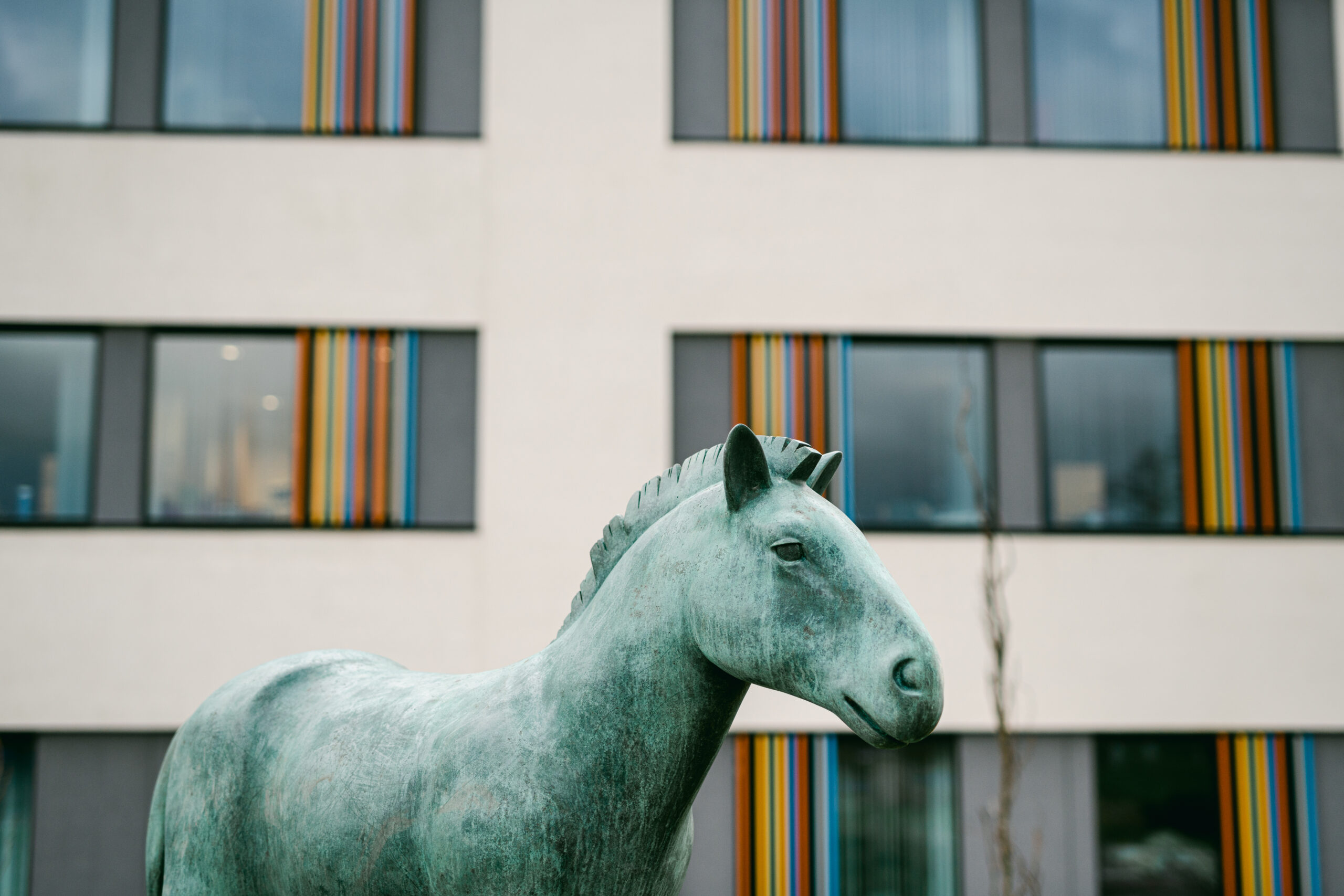
Context and Place: East Lothian
What does it mean to commission artworks for a hospital? There are certain requirements the artists and makers must consider […]
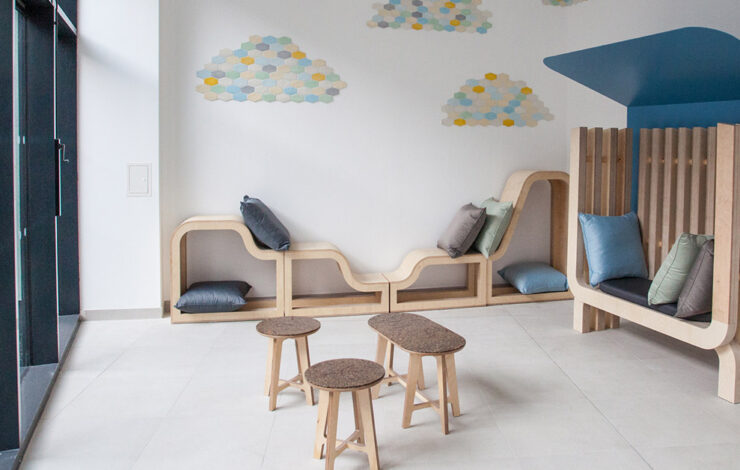
Crafting of Considered Spaces; Mindful Making
In the market town of Haddington in East Lothian, a purpose-built modern healthcare facility is operating with an innovative approach […]